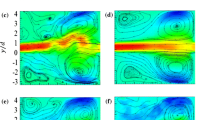Abstract
The mechanism of self-sustained oscillations in laminar cavity flows has been well characterized; however, the occurrence of self-sustained oscillations in turbulent cavity flows has only previously been characterized by direct observation of flows. Here, the quantitative characteristics of vortical structures in turbulent flows over an open cavity were determined, and then statistical properties were examined for evidence of self-sustained oscillations. Specifically, instantaneous velocity fields were measured using PIV and wall pressure fluctuations were determined from microphone data. Cavity geometries of L/D = 1 and 2, where L and D are the length and depth of the cavity, respectively, were used under conditions where the incoming boundary layer was turbulent at Re θ = 830. Statistical analyses were applied based on the instantaneous velocity fields of PIV data. The spatial distributions of vertical velocity correlations (v–v) showed alternating patterns that reflect the organized nature of the large-scale vortical structures corresponding to the modes of N = 2 for L/D = 1 and N = 3 for L/D = 2. These values were consistent with the numbers of vortical structures obtained from a modified version of Rossiter’s equation. Furthermore the numbers of vortical structures determined in the statistical analyses were consistently observed in instantaneous distributions of the swirling strength (λ ci). The incoming turbulent boundary layer can give rise to the formation of large-scale vortical structures responsible for self-sustained oscillations.















Similar content being viewed by others
Abbreviations
- D :
-
depth of the cavity (mm)
- δ :
-
boundary layer thickness (mm)
- δ ω :
-
vorticity thickness (mm)
- Δ:
-
filter width
- f :
-
filter function
- L :
-
length of the cavity (mm)
- L eff :
-
effective length scale (mm)
- ΔL l :
-
length of contamination near the leading edge
- ΔL t :
-
length of contamination near the trailing edge
- λ ci :
-
swirling strength
- λ x :
-
streamwise wavelength of vortical structure (mm)
- θ :
-
momentum thickness (mm)
- R vv :
-
v–v two point correlation coefficient
- R θ :
-
Reynolds number based on the momentum thickness
- R D :
-
Reynolds number based on the depth of the cavity
- St L :
-
Strouhal number based on the length of the cavity
- \( \ifmmode\expandafter\bar\else\expandafter\=\fi{u} \) :
-
filtered instantaneous velocity (m/s)
- U c,avg :
-
convection velocity (m/s)
- v rms :
-
root mean square of vertical velocity (m/s)
- x 0 :
-
streamwise position of reference point (mm)
- y 0 :
-
vertical position of reference point (mm)
References
Ahuja K, Mendosa J (1995) Effects of cavity dimensions, boundary layer and temperature on cavity noise with emphasis on benchmark data to validate computational aeroacoustics codes. Final Report Contract NASA-19061, Task 13. NASA Contract Report
Adrian RJ, Christensen T, Liu Z (2000) Analysis and interpretation of instantaneous turbulent velocity fields. Exp Fluids 29:275–290
Ashcroft C, Zhang X (2005) Vortical structures over rectangular cavities at low speed. Phys Fluids 17:015104
Brown G, Roshko A (1974) On density effects and large structure in turbulent mixing layers. J Fluid Mech 64:775–816
Burroughs CB, Stinebring DR (1994) Cavity flow tones in water. J Acoust Soc Am 95(3):1256–1263
Chang KC, Constantinescu G, Park SO (2006) Analysis of the flow and mass transfer processes for the incompressible flow past an open cavity with a laminar and a fully turbulent incoming boundary layer. J Fluid Mech 561:113–145
Chatellier L, Laumonier Y, Gervais Y (2004) Theoretical and experimental investigations of low Mach number turbulent cavity flows. Exp Fluids 36:728–740
Gharib M, Roshko A (1987) The effect of flow oscillations on cavity drag. J Fluid Mech 177:501–530
Grace SM, Dewar WG, Wroblewski DE (2004) Experimental investigation of the flow characteristics within a shallow wall cavity for both laminar and turbulent upstream boundary layers. Exp Fluids 36:791–804
Hart DP (2000) PIV error correction. Exp Fluids 29:13–22
Howe MS (1997) Low Strouhal number instabilities of flow over apertures and wall cavities. J Acoust Soc Am 102(2):772–780
Larchevêque L, Sagaut P, Mary I, Labbé O (2003) Large-eddy simulation of a compressible flow past a deep cavity. Phys Fluids 15:193–210
Lee SB, Sung HJ (2007) Influence of upstream turbulence on self-sustained oscillations in an open cavity. J Turbulence (submitted)
Lin JC, Rockwell D (2001) Organized oscillations of initially turbulent flow past a cavity. AIAA J 39(6):1139–1151
Little J, Debiasi M, Caraballo E, Samimy M (2007) Effects of open-loop and closed-loop on subsonic cavity flows. Phys Fluids 19(6):065104-065104-15
Liu YZ, Kang W, Sung HJ (2005) Assessment of the organization of a turbulent separated and reattaching flow by measuring wall pressure fluctuations. Exp Fluids 38:485–493
Rockwell D, Kinsely C (1980) Observation of the three-dimensional nature of unstable flow past a cavity. Phys Fluids 23:425–431
Rockwell D, Naudascher E (1978) Review-self-sustaining oscillations of flow past cavities. J Fluids Eng 100:152–165
Rockwell D, Naudascher E (1979) Self-sustained oscillations of impinging free shear layer. Annu Rev Fluid Mech 11:67–94
Rossiter JE (1964) Wind-tunnel experiments on the flow over rectangular cavities at subsonic and transonic speeds. Aeronautical Research Council Reports and Memoranda No. 3438
Sarohia V (1977) Experimental investigation of oscillations in flows over shallow cavities. AIAA J 15(7):984–999
Ukeiley L, Murray N (2005) Velocity and surface measurements in an open cavity. Exp Fluids 38:656–671
Yao H, Cooper RK, Raghunathan S (2004) Numerical simulation of incompressible laminar flow over three-dimensional rectangular cavities. J Fluids Eng 126:919–927
Zhou J, Adrian RJ, Balachandar S, Kendall TM (1999) Mechanism for generating coherent packets of hairpin vortices in channel flow. J Fluid Mech 387:353–396
Acknowledgments
This work was supported by the Creative Research Initiatives of the Korea Science and Engineering Foundation.
Author information
Authors and Affiliations
Corresponding author
Rights and permissions
About this article
Cite this article
Kang, W., Lee, S.B. & Sung, H.J. Self-sustained oscillations of turbulent flows over an open cavity. Exp Fluids 45, 693–702 (2008). https://doi.org/10.1007/s00348-008-0510-8
Received:
Revised:
Accepted:
Published:
Issue Date:
DOI: https://doi.org/10.1007/s00348-008-0510-8




